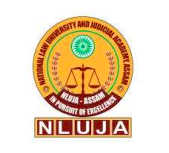 Deadline
15-09-2024
Deadline
15-09-2024
Details of the Organization
National Law University and Judicial Academy, Assam (NLUJAA) was established by the Government of Assam by way of the enactment of the National Law University and Judicial Academy, Assam Act, 2009 (Assam Act No. XXV of 2009).
The Hon'ble Chief Justice of the Gauhati High Court is the Chancellor of the University, NLUJAA promotes and makes available modern legal education and research facilities to its students, scholars, and faculty drawn from across the country, including the North East, hailing from different socio-economic, ethnic, religiosis, and cultural backgrounds.
Details of the Blog/Paper
The NLUA Law Review is one of the flagship journals of the National Law University and Judicial Academy, Assam. The Law Review was established with the objective of becoming a formidable instrument in elevating the standard of legal research in the country to greater heights.
The Law Review is an annual double-blind peer-reviewed journal focusing on inter-disciplinary and multi-disciplinary approaches towards legal study. The Journal is run by a Student Editorial Board and assisted by a Faculty Editorial Board.
Copyright: The journal shall retain all copyrights arising out of any publications and only moral rights will vest with the author.
Topic of paper/Blog
The Journal aims to publish articles, case comments, and book reviews on all aspects of law and related issues. Special emphasis is placed on contemporary legal studies, along with the philosophical reasoning behind the law. The Journal, thus, aims to provide an opportunity to legal academia, research scholars, students, advocates, and activists working for the enhancement of the legal landscape through scholarship.
Eligibility
The Editorial Committee of NLUA Law Review is inviting quality research papers from:
- Academicians and professionals (inter/multidisciplinary with law);
- Judges and Advocates;
- Research Scholars and;
- Students.
Types of Submission and Word Limit
Research papers should be thematic, with the identification of sub-themes being appreciated. Submissions must frame appropriate research questions, with the findings being reflective of the questions posed. Submissions can be sent under the following categories:
- Research Articles (5000 and 7000 words): Authors must submit research papers that comprehensively examine the topic of choice. The article must reflect an innovative re- assessment of the theme. It is encouraged, though not necessary, to choose a theme that is of contemporary importance. Purely theoretical-analytical pieces are also welcome.
- Notes/Comments (2000 and 3500 words): Submissions under the Noted and Comments category must be thought-provoking and innovative pieces consisting chiefly of personal opinions, analysis, or criticism of recent developments from a legal perspective.
- Case/Report Comments (maximum 2500 words): Submissions under Case Reports and Comments should entail an analysis of recent relevant Indian or International judicial pronouncements. Submissions must identify and examine the line of cases through which the decision in question came about, and comment on implications for the evolution of the branch of law in question.
- Book Reviews (1000 and 1500 words): The Reviewer should identify the relevant arguments put forth by the author and present a comprehensive analysis of the same. A hard copy of the book must be provided.
Submission Guidelines
- Submissions should be in Georgia, font size 12, 1.5 line spacing, justified text, and 1-inch margins on all sides of an A4 page.
- Footnotes must be in Georgia, font size 10, with 1.0 line spacing.
- Endnotes and/or Bibliography and in-text citations are not allowed.
- Graphics, Charts, Tables, and Diagrams should be numbered consecutively when included in the body of the work.
- Headings should follow the following standard:
- a. TITLE OF THE SUBMISSION: Upper-case, bold, font size 14
- HEADINGS: Upper-case, bold, font size 14
- Sub-Headings: Title-case, bold, font size 12
- Sub-Sub-Heading: Title-case, italics, font size 12
- Submissions must contain an Abstract (250-300 words) that outlines the main questions or themes addressed in the paper, followed by five keywords.
- Submissions must be the original work of the author and are liable to be rejected if they are found to be plagiarised or contain excessive use of AI generated content.
- Submissions must be exclusive and must not be under concurrent consideration elsewhere.
- Co-authorship is allowed. The maximum number of authors for a single submission shall be two.
- Mode of citation will be OSCOLA (Oxford University Standard for the Citation of Legal Authorities), 4 th Edition.












 ADDICTIVE LEARNING TECHNOLOGY LIMITED
ADDICTIVE LEARNING TECHNOLOGY LIMITED